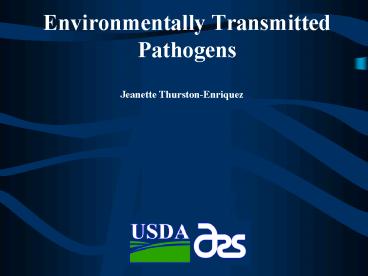Environmentally Transmitted Pathogens PowerPoint PPT Presentation
1 / 23
Title: Environmentally Transmitted Pathogens
1
Environmentally Transmitted Pathogens
Jeanette Thurston-Enriquez
2
To Take Away
- Waterborne outbreaks not only impact human health
but also the economy - Ag runoff from manured land can carry human
enteric pathogens - Pathogenic bacteria are not the ONLY threats
- Should not only be concerned with DW
suppliesrecreational, irrigation, shellfish
harvesting - Commonly applied bacterial indicators may not
reflect human health threats
3
Waterborne Disease in the U.S.
- lt20 drinking and recreational water outbreaks/yr
- estimated to be 10-100 x higher
4
Water Sources That Can Be Threatened By
Waterborne Pathogens
Recreational
Irrigation
Drinking
Seafood
5
(No Transcript)
6
Etiological Agents of Waterborne Disease,
United States, 1991-2000
Drinking Water
gt425,000 illnesses 1993, Milwaukee, 403,000
7
Drinking Water Outbreaks
- Milwaukee, 1993
- Municipal wastewater contamination of surface
water - Cryptosporidium parvum
- gt400,000 cases, 4400 hospitalizations
- gt50 fatalities
- Walkerton, 2001
- Agricultural runoff to groundwater supply
- Escherichia coli O157H7 Campylobacter
- gt2000 cases
- 7 fatalities
8
Etiological Agents of Waterborne Disease,
United States, 1991-2000
Recreational Outbreaks Surface Water
gt4500 illnesses
9
Recreational Water Outbreaks
- Cryptosporidium and pools/spas
- Naegleria in ponds, puddles, lakes
- Usually fatal
- Pathogenic bacteria in freshwater (E. coli
O157H7, Shigella, etc) - 1991-2000
- 19 outbreaks/yr
- 1689 illnesses/yr
- 1999
- Clark County, Washington
- Lake
- E. coli O157H7
- 1041 cases, 65 hospitalized
- no fatalities
10
Foodborne Outbreaks Associated with Contaminated
Water
- Fresh Produce
- 1996, Cyclospora, Guatemala/multi-state
- Raspberries
- Contaminated irrigation water suspected as
pathogen source - gt1400 illnesses
- Ice
- 1999, Norwalk virus, Anchorage AK
- Contaminated water used to make ice
- 400 illnesses, 1 fatality
- Shellfish
- 1991, China, Hepatitis A
- Fecal pollution of clam harvesting water
- gt290,000 illnesses
- Food Processing
- 1990, S. Carolina/multi-state, Salmonella
- Tomatoes
- Contamination of water bath used by packer
- 174 illnesses
11
Costs of Contaminated Water
- Medical Expenses
- Time lost from work/Loss of productivity
- Miscellaneous supplies
- Legal expenses
- Changes in current practices
- Water municipalitiestreatment
- Individual consumer changes-POUs
- Loss of consumer confidence
12
Enteric vs. Non-Enteric Pathogens Implicated in
Waterborne Disease Outbreaks 1991-2000
Recreational/Surface Water
Drinking water
13
Examples of Enteric Pathogens that Threaten
Water Supplies
Bacteria
Protozoan Parasites
Campylobacter
Cryptosporidium
Shigella
Giardia
Escherichia coli
Salmonella
Enteric Viruses
Noroviruses
Emerging Pathogens
Enteroviruses
Microsporidia
14
Enteric Pathogen Illness
- Fecal-oral route
- Wide range of disease
- Diarrhea to respiratory disease, paralysis,
encephalitis, hepatitis - Usually mild and self-limiting
- Medical attention not usually sought
- Severe illness in some cases
- Economic Costs
- Mild disease 280
- Severe disease 8000
15
Enteric PathogensContributing Factors for
Environmental Persistence and Transmission
- High numbers shed in feces
- Increased survival
- Low infectious dose
- Increased resistance to disinfection/treatment
- Multiple routes of transmission
- Animal and human infections
16
Microbiological Water Quality AssessmentIndicato
r Microorganisms
- Drinking water
- Total coliforms
- lt5 positive (presence/absence)
- E. coli
- zero
- Recreational water
- Primary contact (bathing beaches)
- E. coli 126 CFU/100ml
- Secondary Contact
- 2o 5X 1o contact standards
17
Criteria for Ideal Indicators
- useful for all water types
- present whenever pathogen present
- longer survival than hardiest pathogen
- no multiplication in water
- easy and low cost detection method
- be a member of the intestinal micro flora of warm
blooded animals - relationship between indicator and degree of
fecal pollution
18
Deficiencies in Use of Microbial Indicators
- Indicator absence ? pathogen absence
- Indicator presence ? pathogen presence
- Regrowth in aquatic environments
- Regrowth in distribution systems
- Suppression by high background bacterial growth
- Not indicative of a health threat
- No relationship between enteric viruses or
protozoan pathogens
19
Failure of Water Testing Indicator
Microorganisms
- 35 of gastrointestinal illness was estimated to
be attributable to the consumption of drinking
water meeting current water quality standards - (Payment et al., 1991)
- Outbreaks
- Drinking water Milwaukee (indicators absent)
(1993) - Recreational water E. coli O157H7 (indicators
did not exceed stds) (1999)
Escherichia coli
Enterococci
Fecal coliforms
20
Barriers Against Waterborne Disease
- Drinking water and wastewater treatment
- Disinfection
- Filtration
- Water testing
- Surface water monitoring/Source water protection
- Point-of-use devicesdisinfect/filter
- Disinfectant use in recreational water (pool and
spa)
21
Conclusions Impact of Pathogens in Water
- Human and Animal Health ? Economy
- Many Pathogen and Water Sources (human,
livestock, wildlife, domestic animals) - Water and food supplies
- Multiple routes for pathogen transmission
dissemination - Water Quality Assessment has not been a reliable
indication of a disease threat
22
Information Gaps Needs
- METHODOLOGIES
- Viable/infectious, detection, enumeration
- PATHOGEN FATE AND SURVIVAL
- Established emerging pathogens
- Appropriate indicators
- Environment treatment
- INDICATOR MICROORGANISMS
- Relationship to human health risk?
- Established emerging pathogens
23
Information Gaps Needs
- WATER TREATMENT
- Efficacy vulnerabilities
- LIVESTOCK MANAGEMENT PRACTICES
- Pathogen transport to water
- Pathogen reduction by manure management practices
- LOW-COST REDUCTION STRATEGIES
- Manure management, surface water protection,
water treatment alternatives, emergency relief
efforts, etc. - RISK ASSESSMENTS

